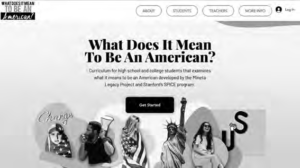In this review, I focus on how the What Does It Mean to Be an American? (www.whatdoesitmeantobeanamerican.com) curriculum relates to the study of Asia in high schools and colleges. The review focuses on the curriculum’s methodology, the Mineta Legacy Project (Stanford Program on International and Cross-Cultural Education [SPICE] curriculum developers were invited to create a companion curriculum to complement the documentary Norman Mineta and His Legacy: An American Story) and the goals and content of the curriculum. General knowledge of Asia, important for decades in American education, appears to be more imperative than ever as Xi Jinping’s China appears now to threaten what it means to be an American. At the risk of digression, anyone who reads this review is encouraged to learn more about Norman Mineta, which they can easily do through this curriculum package. Mineta is a great American.
The curriculum is divided into six sections (Immigration, Civil Liberties and Equity, Civic Engagement, Justice and Reconciliation, Leadership, and US-Japan Relations) and is based upon “Understanding by Design.” This pedagogy enables a high level of student engagement in lessons with the teacher acting as a facilitator. In the first section, students examine issues regarding immigration and draw connections with today. They learn about treatment of Japanese-Americans during World War II and reflect on the perspectives of people of color and different religions in the contemporary US. It is within this section that we gain insight into how this curriculum is formatted in a way that uses one event in American history to move into current issues that often don’t focus upon learning about Asian topics.
In the second and third sections, students learn about Civil Liberties and Equity beginning with the Constitution, and subsequently focus upon the internment of Japanese-Americans and discuss how to create civil engagement within the classroom and in the larger society to hopefully create positive change. In these sections, especially the second, knowledgeable teachers can discern elements of Critical Race Theory in the curriculum. Although I am not opposed to introducing CRT as one perspective in considering civic engagement nor in encouraging students (assuming they have basic content knowledge in addition to what is provided in this curriculum package) to become young engaged citizens, the direct connection to Asian studies in high school and university survey courses is not a main focus of this section.
In the fourth section of this curriculum, teachers and students explore the topic of justice and reconciliation, specifically through the story of how Japanese-Americans were treated by the American government due to their ethnic background rather than their loyalty to and support of the US. The curriculum uses this major injustice to accentuate other historical and, allegedly, contemporary US government ill treatment of American citizens and gives examples for the student to view other incidents in American history, as well as read and analyze how a variety of famous people in history, religion, and literature define justice. I question whether the American internment of Japanese-Americans, while certainly open to severe criticism for several reasons, should be used as a springboard into, in many ways, completely different topics.

Even though the connections to Asian studies are tenuous, I found the Leadership section of the curriculum beneficial to students. The unbiased and interesting treatment of the topic of leadership is potentially inspirational for many students who will be the leaders of tomorrow. Because the SPICE team was working with independent filmmakers, they produced some succinct but quite interesting videos involving respectively, interviews with living former presidents and members of Congress.
In the sixth and final section, the reader sees and gains substantive insights into the connection among Asia, Japan and our nation. The section does a very good job in discussing the connection. With some exceptions, notably a lack of discussion regarding Imperial Japanese forces actions in World War II and Japan’s underreported role in helping the US win the Cold War, the historical and contemporary aspects of US–Japan relations are well done. At the high school level, Tennessee standards (as an example) are content-specific and especially include Japan in the fused US history and geography standards, as well as the world history and geography standards. The US–Japan Relations module, despite modest content on World War II, is helpful in teaching some of this content, particularly the post-war standards
In summary, the curriculum has definite strong points as well as some problems I’ve identified, with the biggest problem being a lack of inclusion of more focused Asian/Japanese studies content.

